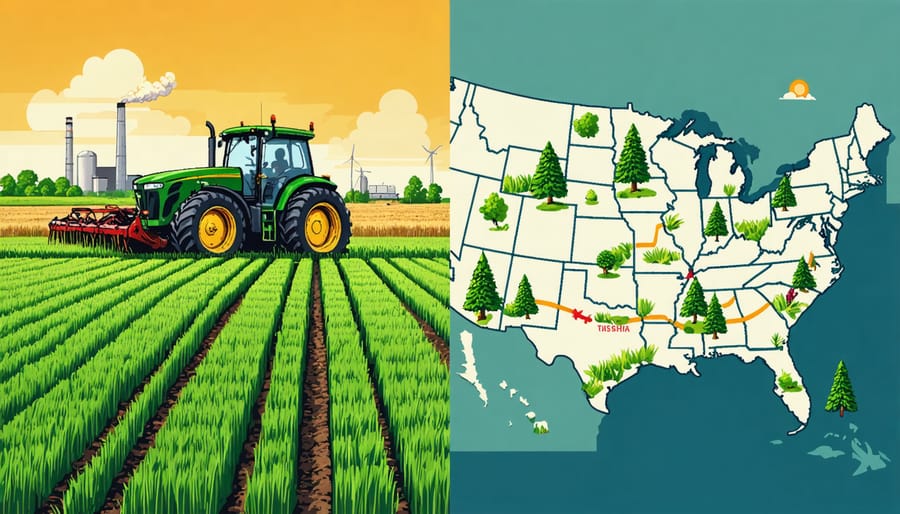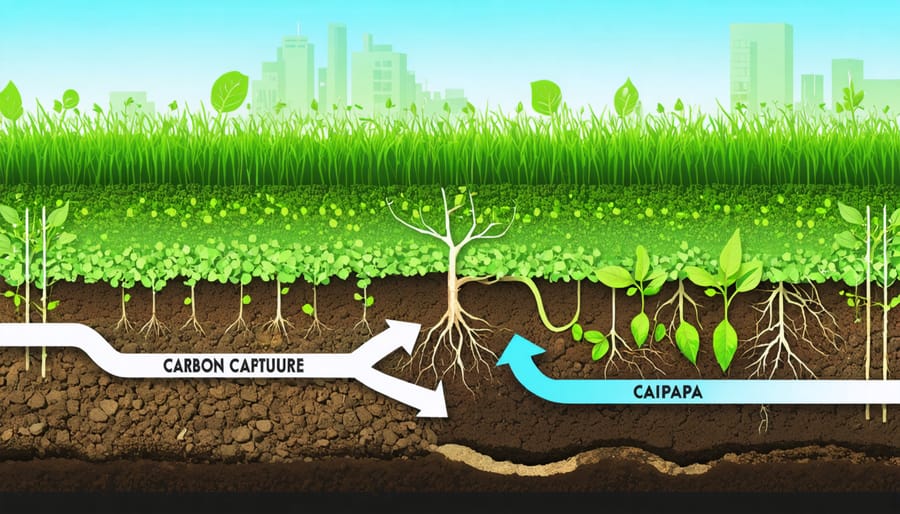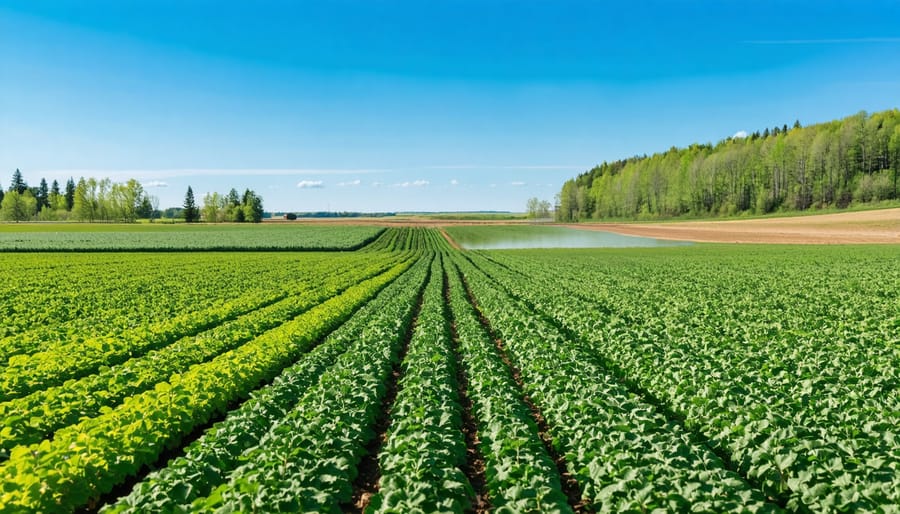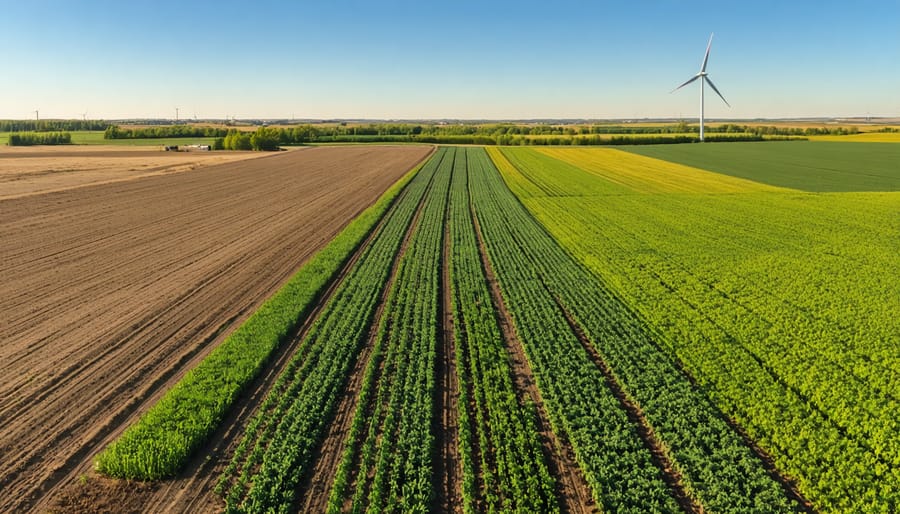Transform your soil into a carbon-storing powerhouse while creating new revenue streams for your farm. Soil organic carbon – the backbone of healthy agricultural land – represents one of the most promising opportunities for Canadian farmers to combat climate change while improving their bottom line.
Alberta farmers are uniquely positioned to capitalize on emerging carbon markets, with our province’s rich agricultural heritage and innovative carbon offset programs leading the way. By implementing strategic management practices, farmers across the prairies are already earning additional income while building more resilient soils for future generations.
The science is clear: every 1% increase in soil organic carbon can store an additional 27 tonnes of carbon per hectare while boosting water retention by up to 25,000 litres. For the average Alberta farm, this translates to both environmental benefits and tangible economic returns through improved crop yields and potential carbon credit revenues.
Whether you’re managing a multi-generation family farm or starting fresh with regenerative practices, understanding soil organic carbon is no longer optional – it’s essential for future-proofing your agricultural operation and accessing new market opportunities in Canada’s evolving carbon economy.
Understanding Soil Carbon Products in Agriculture
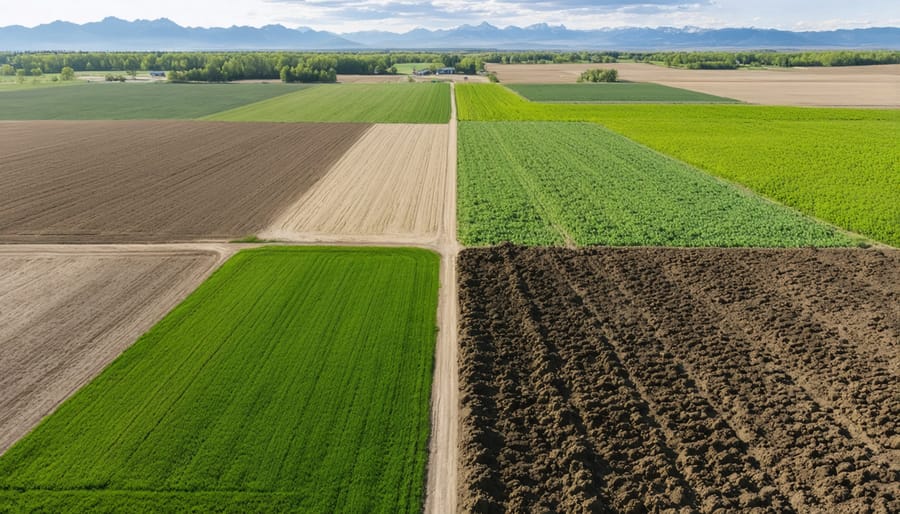
Common Soil Carbon Products
Several profitable soil carbon products have emerged in Alberta’s agricultural market, offering farmers new revenue streams while promoting sustainable practices. Carbon credits are the most common tradeable product, allowing farmers to earn income by implementing practices that increase soil organic carbon. Through Alberta’s emission offset system, farmers can sell these credits to companies looking to meet their environmental obligations.
Biochar, a carbon-rich material produced from agricultural waste, has gained popularity as both a soil amendment and carbon storage solution. When applied to fields, it improves soil structure while sequestering carbon for hundreds of years. Local processing facilities are now purchasing crop residues from farmers to produce biochar.
Specialty soil amendments enriched with organic carbon are also finding their way to market. These products include composted materials, vermicompost, and organic fertilizers that help build soil carbon while improving crop yields. Many Alberta farmers have successfully developed their own branded soil amendment products, selling to local gardeners and other farmers.
The emerging carbon certification market allows farmers to earn premium prices for crops grown using carbon-sequestering practices, creating additional value from soil carbon management.
Current Market Demand
The market for soil organic carbon credits is experiencing significant growth, particularly in Alberta where carbon offset programs are well-established. Current trading prices range from $30 to $50 per tonne of sequestered carbon, with projections suggesting continued price increases as demand grows. Major companies across Canada are actively seeking agricultural carbon credits to meet their emissions reduction targets.
International markets are similarly robust, with European and American buyers showing strong interest in Canadian soil carbon credits. Alberta farmers are uniquely positioned to benefit from this demand due to the province’s established carbon trading framework and verification systems.
Local agri-food companies are increasingly partnering with farmers who demonstrate strong soil carbon management practices, offering premium prices for crops grown using carbon-sequestering methods. These partnerships often include long-term contracts that provide stable income streams for farmers while meeting corporate sustainability goals.
The voluntary carbon market has shown particular promise, with many private sector buyers willing to pay above-market rates for high-quality agricultural carbon credits. This trend is expected to continue as more companies commit to net-zero targets and seek verified carbon offsets from the agricultural sector.
Economic Benefits for Alberta Farmers
Carbon Credit Markets
Alberta farmers are increasingly participating in soil carbon credits as a way to generate additional income while promoting sustainable agriculture. Through carbon credit markets, farmers can earn credits for implementing practices that sequester carbon in their soil, which can then be sold to companies looking to offset their emissions.
To participate, farmers typically need to document their baseline soil carbon levels and demonstrate measurable increases through approved management practices. Common eligible activities include reducing tillage, implementing cover crops, and improving crop rotations. Currently, Alberta’s carbon offset system offers around $15-30 per tonne of carbon sequestered, with prices expected to rise as markets mature.
Local success stories include the Brown family farm near Lethbridge, which earned $45,000 in their first two years of participation by converting to no-till practices across 2,000 hectares. To get started, farmers should connect with registered carbon credit aggregators who can guide them through the verification process and help access markets.
Remember that participation requires a long-term commitment, typically 5-10 years, and careful record-keeping. Many agricultural extension offices offer free consultations to help farmers evaluate their carbon credit potential and develop implementation strategies that work for their operations.
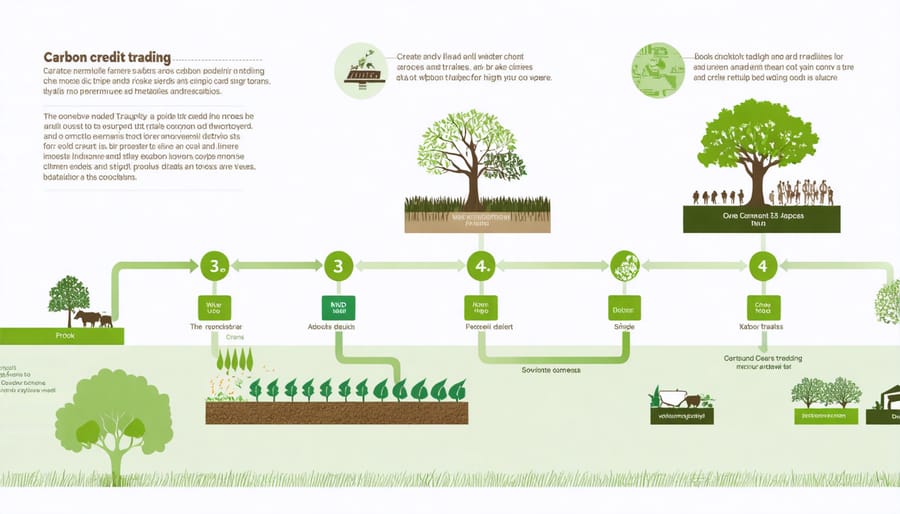
Value-Added Products
By implementing effective soil carbon management practices, farmers can tap into premium market opportunities that go beyond traditional crop yields. Carbon-rich soils contribute to higher-quality produce that often commands better prices in specialty markets. For example, many Alberta farmers have successfully marketed their crops as “carbon-smart” or “regeneratively grown,” attracting environmentally conscious consumers willing to pay more for sustainably produced food.
Some innovative producers have developed value-added products like specialty flours and grains that highlight their carbon-conscious farming methods. These products often sell at a 15-30% premium compared to conventional alternatives. Local success stories include farms that have created their own branded lines of heritage grains grown in carbon-enriched soils, which are particularly popular among artisanal bakeries and health food stores.
Carbon credits represent another significant value-added opportunity. Through Alberta’s carbon offset program, farmers can earn approximately $15-30 per tonne of sequestered carbon. Several community-based aggregator programs help smaller operations bundle their carbon credits to access these markets more effectively.
Soil testing and monitoring services have also emerged as a promising business venture. Some farming operations have developed expertise in soil carbon measurement and now offer consulting services to other producers, creating an additional revenue stream while promoting sustainable practices within the agricultural community.
Implementation Strategies
Soil Management Techniques
Implementing effective carbon farming practices starts with understanding your soil’s current condition. Regular soil testing helps establish baseline carbon levels and guides your management decisions. Here in Alberta, we’ve seen remarkable success with practices like minimal tillage and diverse crop rotations.
Consider implementing cover crops between main growing seasons, particularly cold-hardy varieties like fall rye or winter wheat that thrive in our climate. These plants protect the soil surface and contribute organic matter even during our harsh winters. Adding livestock to your rotation through managed grazing can also boost organic carbon levels while providing additional income streams.
Proper residue management is crucial – leaving crop residues on the field rather than removing them helps build organic matter over time. Many Alberta farmers have found success with composting and applying organic amendments like manure or biochar when available.
Remember to adjust your fertilizer program based on soil test results and crop needs. Over-application can actually decrease soil organic carbon by stimulating excessive microbial activity. Monitor your progress through regular soil testing and keep detailed records of your management practices.
Starting small with these techniques on a test plot can help you gain confidence before implementing them across your entire operation. Many local agricultural extension services offer support and guidance for transitioning to these sustainable practices.
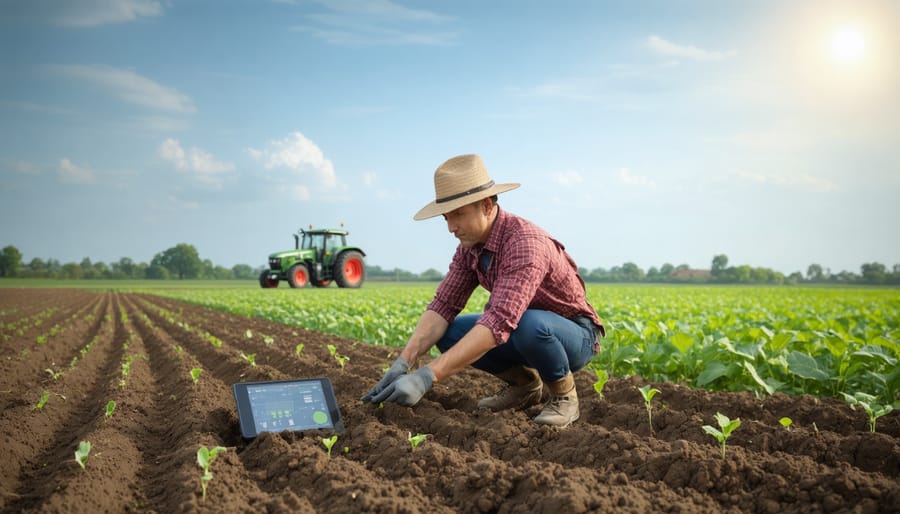
Technology and Tools
Modern technology has revolutionized how we measure and monitor soil organic carbon, making it easier for Alberta farmers to track their progress and verify carbon credits. Traditional soil sampling remains important, but new tools are making the process more efficient and accurate.
Hand-held spectral devices now allow for rapid field testing, providing immediate readings of soil carbon levels without the need for laboratory analysis. These devices use infrared technology to scan soil samples, giving farmers quick insights into their soil health.
Satellite imagery and drone technology are becoming increasingly valuable for mapping soil carbon across large areas. These tools use specialized sensors to detect variations in soil properties, helping farmers identify areas that need attention and track changes over time.
Mobile apps and digital platforms have simplified data collection and record-keeping. Many Alberta farmers are using smartphone applications to log soil test results, management practices, and track carbon credit opportunities. These digital tools often integrate with GPS technology to ensure accurate field mapping and documentation.
Laboratory testing has also advanced, with more precise carbon analysis methods available. The standard walk-in sampling grid method, combined with advanced laboratory analysis, provides the most accurate baseline measurements for carbon credit programs.
Remote sensing technologies are helping farmers monitor vegetation health and biomass production, which are indirect indicators of soil carbon levels. These tools, when combined with traditional methods, create a comprehensive approach to soil carbon monitoring that meets both practical farming needs and carbon credit verification requirements.
Cost-Benefit Analysis
Implementing soil carbon management practices requires careful consideration of the costs of soil carbon storage against potential financial returns. Initial investments typically include soil testing ($150-300 per field), equipment modifications ($5,000-15,000), and possible changes in crop rotation systems. However, Alberta farmers report significant returns within 3-5 years through multiple revenue streams.
Direct benefits include increased crop yields (10-30% improvement), reduced fertilizer costs (savings of $30-50 per acre), and enhanced water retention leading to irrigation savings. Additionally, carbon credit programs in Alberta can generate $15-30 per acre annually, depending on management practices and verification requirements.
Local success stories demonstrate the financial viability. The Thompson family farm in Red Deer County invested $12,000 in soil carbon management practices and recovered costs within two growing seasons through improved yields and reduced input costs. They now earn an additional $25,000 annually through carbon credits and premium pricing for their crops.
When factoring in long-term soil health improvements, reduced erosion risks, and increasing carbon market values, the return on investment becomes even more attractive. Many farmers also report decreased operational costs after the initial transition period, with fuel savings of up to 20% and reduced equipment wear.
Success Stories from Alberta
Small-Scale Success
The Davidson family farm in Lacombe County, Alberta, offers an inspiring example of successful soil carbon management on a smaller scale. Sarah and Mike Davidson, third-generation farmers operating 160 hectares, began their soil health journey five years ago by implementing no-till practices and diverse crop rotations.
“We started small, focusing on a 40-hectare test plot,” Sarah explains. “Within three years, our soil organic carbon levels increased by 0.5%, and we noticed significant improvements in soil structure and water retention.” The Davidsons’ approach included planting cover crops like clover and rye between their main cash crops of canola and wheat.
Their initiative caught the attention of local carbon credit programs, and they now earn an additional $45 per hectare annually through carbon sequestration payments. More importantly, they’ve reduced their fertilizer costs by 20% due to improved soil fertility.
The Davidsons actively share their experiences with neighboring farms through field days and community workshops. “What works for us might need tweaking for others,” Mike notes, “but the principles remain the same: start small, monitor progress, and adjust based on results.”
Their success demonstrates that meaningful carbon sequestration is achievable for small-scale operations, providing both environmental and economic benefits while maintaining productive farming operations.
Large-Scale Implementation
The Henderson Family Farm in Red Deer County stands as a remarkable example of successful large-scale soil organic carbon implementation. Operating across 2,000 hectares of mixed cropland, the Hendersons have demonstrated how achieving long-term profits from carbon-rich soil is possible through systematic changes in farming practices.
Over five years, the Hendersons transitioned from conventional tillage to a comprehensive no-till system, incorporating cover crops and implementing rotational grazing. Their approach included planting diverse cover crop mixtures, featuring species like clover, rye, and radish, which contributed to increasing their soil organic carbon levels by 2% across their operation.
The results have been significant: their fertilizer costs decreased by 30%, while crop yields increased by 15% compared to regional averages. Water retention improved dramatically, allowing them to maintain productivity even during drier seasons. The farm now sequesters an estimated 5 tonnes of carbon per hectare annually, participating in Alberta’s carbon offset program.
Key to their success was the gradual implementation, starting with 200-hectare test plots before expanding the practices across their entire operation. The Hendersons also collaborated with local agricultural extension services and participated in soil health workshops, sharing their knowledge with neighboring farms and contributing to a growing community of carbon-conscious farmers in central Alberta.
Managing soil organic carbon is more than just an environmental responsibility – it’s a promising opportunity for Alberta’s farming community. By implementing the practices we’ve discussed, from reduced tillage to cover cropping, you can improve your soil health while potentially accessing new revenue streams through carbon offset programs. The science is clear: healthy soils with high organic carbon content lead to better yields, increased resilience to weather extremes, and a more sustainable future for agriculture. Take the first step today by assessing your current soil conditions and choosing one practice to implement this growing season. Together, we can build a stronger, more sustainable agricultural sector while contributing to Canada’s climate goals and securing our farms’ prosperity for generations to come.



